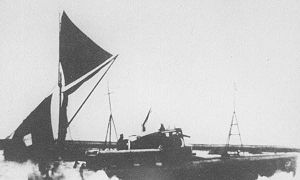Patrol torpedo boat Q-111 Luzon
 Imperial Japanese Navy Torpedo Boat No. 114 (circa 1943)
| |
| History | |
|---|---|
| Name | Q-111 Luzon |
| Builder | John I. Thornycroft & Company, Southampton |
| Laid down | 15 April 1938 |
| Launched | 1939 |
| Sponsored by | Commonwealth of the Philippines |
| Homeport | Manila |
| Fate | scuttled, 9 April 1942 |
| History | |
| Name | Patrol Boat No. 114 |
| Commissioned | 12 April 1943 |
| Fate | Sunk by attack by aircraft, 1944/1945 |
| General characteristics | |
| Type | Motor torpedo boat |
| Tonnage | 20 gross register tons[1] |
| Length | 19.8 m (65 ft 0 in) o/a |
| Beam | 4.7 m (15 ft 5 in) |
| Draught | 1.5 m (4 ft 11 in) |
| Installed power | 1800 bhp |
| Propulsion | 3 Thornycroft petrol engines, 3 shafts |
| Speed | 41 knots |
| Complement | 6 |
| Armament | 3 x .50 caliber machine guns, 2 x 21" torpedo tubes, 2 x Mark 14 torpedoes, 4 depth charges |
Q-111 Luzon was a motor torpedo boat of the United States Army during World War II as part of the Offshore Patrol based at Manila.
History
In 1935, the
Q-111 differed in that she was larger and had fixed deck torpedo tubes while Q-112 had two torpedoes in stern troughs.
On 17 January 1942, Q-111 and Q-112 were patrolling off the east coast of Bataan when they were attacked by nine Japanese dive bombers.
Q-111 was re-floated, rebuilt, and commissioned into service on 12 April 1943 by the Imperial Japanese Navy as Patrol Boat No. 114.[8][12][13] In 1944 or 1945, she was sunk by US Naval aircraft in the Philippines.[8]
References
- ^ ONI 208-J (Supplement no. 2) Far Eastern Small Craft. Division of Naval Intelligence. March 1945. p. 10.
- ^ Zulueta, Joselito. "History of the Philippine Navy". Philippine Navy. Archived from the original on 17 February 2010. Retrieved 21 July 2012.
- ^ ISBN 9781591141938.
- ^ a b c d e f g h i "They Were Expendable Too: The Torpedo Boats of the Off-Shore Patrol". The Bataan Campaign. 22 February 2014.
- ^ a b "The Philippine Navy" (PDF). De La Salle University.
- ^ "Torpedo Boats Strike in the Pacific". Life (magazine). 9 February 1942.
- ^ a b "Wartime Coastal Patrol - December 1941" (PDF). Orosa family - Batangas province.
- ^ a b c d e f g h i j k "Philippine Motor Torpedo Boats of WW2". warsailors.net. 3 December 2018.
- ^ "Diary Of Ramon A. Alcaraz". The Philippine Diary Project. 27 December 1941.
- Republic of the Philippines. 6 August 2013.
- ^ "Diary Of Ramon A. Alcaraz". The Philippine Diary Project. 3 February 1942.
At high noon today, enemy planes bombed Lamao area where Capt Jurado's OSP Inf Bn is deployed. Patrol Boat 'Danday', Lt Abraham Campo USNA '40 CO was a direct hit to pieces. Luckily, Abe, who used to be my ExO and his crew were taking their lunch ashore, are spared. There are no casualties but a few buildings were razed. The "Danday" under Lt Campo, had several successful night missions before smuggling PC intelligence operatives from Bataan to Manila and back.
- ^ "第114号魚雷艇(元比海軍魚雷艇) Torpedo boat Type "No.114" (Philippine Navy "Q111 Luzon")". military.sakura.ne.jp (in Japanese). Retrieved 14 April 2020.
- ^ Japanese Naval Vessels at the End of the War (PDF). 25 April 1947. p. 134.
